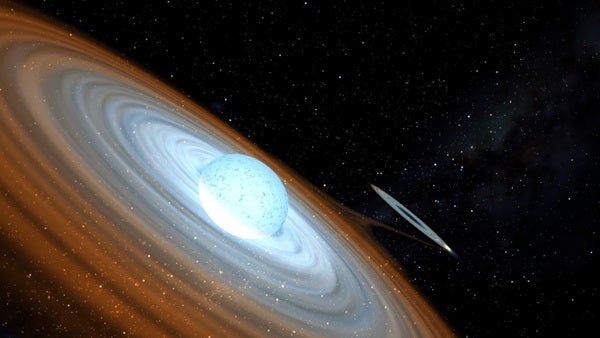Be-type stars are quite common across the universe. In our galaxy alone, more than 80 of them are known in binary systems together with neutron stars. “Their distinctive property is their strong centrifugal force — they rotate very fast, close to their break-up speed. It’s like they were cosmic spinning tops,” said Jorge Casares of the Institute of Astrophysics in the Canary Islands (IAC).
The newly discovered black hole orbits the Be star known as MWC 656, located in the constellation Lacerta the Lizard, which is 8,500 light-years from Earth. The Be star rotates so fast that its surface speed exceeds 620,000 mph (1 million km/h). “We started studying this star back in 2010 when space telescopes detected transient gamma-ray emission coming from its direction,” said Marc Ribó from the Science Institute of the Cosmos at Barcelona University. “No more gamma-ray emission has subsequently been detected, but we found that the star was part of a binary system.”
A detailed analysis of its spectrum allowed scientists to infer the characteristics of its companion. “It turned out to be an object with a mass between 3.8 and 6.9 solar masses,” said Ignasi Ribas of CSIC at the Institute of Space Sciences. “An object like that, invisible to telescopes and with such large mass, can only be a black hole because no neutron star with more than three solar masses can exist.”
The black hole orbits the more massive Be star and is fed by matter ejected from the latter. “The high rotation speed of the Be star causes matter to be ejected into an equatorial disk,” said Ignacio Negueruela at the University of Alicante. “This matter is attracted by the black hole and falls on to it, forming another disk, called an accretion disk. By studying the emission from the accretion disk, we could analyze the motion of the black hole and measure its mass.”
Scientists believe this object to be a nearby member of a hidden population of Be stars paired with black holes. “We think these systems are much more common than previously thought, but they’re difficult to detect because their black holes are fed from gas ejected by the Be stars without producing much radiation, in a ‘silent’ way, so to speak,” said Casares. “However, we hope to detect other similar binary systems in the Milky Way and other nearby galaxies by using bigger telescopes, such as the Gran Telescopio Canarias,” said Casares.
Black holes, an ongoing challenge
The detection of black holes has been a challenge since their existence was first surmised by John Michell and Pierre Laplace in the 18th century. Given that they are invisible, their enormous gravitational force prevents light from escaping — telescopes cannot detect them. However, black holes can occasionally trigger high-energy radiation from the environment surrounding them and can thus be traced by X-ray satellites. This is the case with active black holes fed by matter transferred from a nearby star. If violent X-ray emission is detected from a place where nothing but a normal star is seen, a black hole might be hiding there.
Using this method, researchers have discovered 55 potential black holes over the last 50 years. 17 of those have what astronomers call a “dynamic confirmation” — the feeding star has been localized, allowing for the mass of its invisible companion to be measured. If it is above 3 solar masses, then it is considered to be a black hole.
The biggest problem is put forth by “dormant” black holes, such as the one found by the Spanish researchers. “Their X-ray emission is almost absent, and so it is very unlikely that our attention would be drawn to them,” said Casares. Researchers believe there are thousands of black hole binary systems across the Milky Way, some of them also with Be-type stellar companions.










